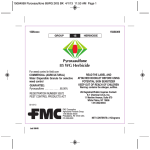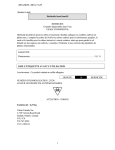Download RESUMEN El objetivo general de esta tesis fue investigar las
Transcript
RESUMEN El objetivo general de esta tesis fue investigar las características del crecimiento, reproducción y tolerancia al sombreado W. glauca. Para el estudio se integraron experimentos en laboratorio y a campo. Los resultados se resumen seguidamente. En el Capitulo 1 se presenta una revisión bibliográfica sobre la especie y descripción del área de estudio. El Capítulo 2 se ocupa de germinación y brotación de rizomas.Entre los factores que favorecen la propagación de W. glauca se encuentra la capacidad de sus frutos para germinar en un rango amplio de temperaturas tanto en condiciones de oscuridad continua y bajo un fotoperíodo de luz y oscuridad, los máximos porcentajes fueron 18 a 22º C y a 20/10 ºC. En condiciones salinas, una proporción de los frutos pueden germinar hasta concentraciones de cloruro de sodio de 200 mM hecho que permite considerarla con un comportamiento similar a especies halófitas. No ocurrió emergencia a partir de frutos colocadas a profundidades mayores a 3 cm, operaciones de labranza que entierren las semillas a profundidades mayores puede ser una opción para limitar la germinación de esta maleza, coligado este fenómeno al hecho que la supervivencia de los frutos en el banco es efímera, no mas de doce meses. El flujo de emergencia de plántulas provenientes de semilla es discontinuo con cohortes en otoño y primavera. La capacidad de regeneración de los rizomas, indica que esta sería una de las estrategias biológicas más importantes coligada a la expansión y perpetuación de la especie en las áreas invadidas. El inicio de brotación fue a partir de los 12º C, obteniéndose porcentajes superiores al 50 % en el rango de 18 a 30º C. La longitud del fragmento de rizoma influye en la formación de brotes vegetativos, al aumentar la longitud de los segmentos se incrementó el porcentaje de brotación. Como se citó en el caso de los frutos, existió una tolerancia de la brotación de los rizomas a un cierto grado de salinidad, siendo nula en concentraciones salinas superiores a 200 mM. La profundidad de entierro y el diámetro de los rizomas afectaron la emergencia de vástagos. El mayor porcentaje de brotación se obtuvo para los rizomas de mayor grosor y plantados superficialmente, a profundidades superiores a los 30 cm la emergencia de vástagos fue escasa o nula. Si bien la actividad de regeneración de los rizomas mostró fluctuaciones a lo largo del ciclo anual de crecimiento, no existió ningún momento en que dicho proceso fuera totalmente interrumpido. En el Capitulo 3 se exponen los resultados referidos a Fenología, crecimiento y desarrollo en condiciones de campo y a partir de una planta originada por germinación de su fruto. Del estudio fenológico surge queW. glauca es una especie de crecimiento primavera-estival, durante el invierno la porción aérea de la planta senesce; sin embargo, pueden emerger nuevos vástagos durante dicha estación por aumento de la temperatura y humedad del suelo por riego, consecuentemente puede morir por ocurrencia de una helada posterior. Con respecto a crecimiento y desarrollo en condiciones de campo, la evolución de la biomasa seca aérea incrementa en primavera-verano; alcanzando su máximo a comienzos del verano y desciende a partir de esta estación hasta desaparecer la porción aérea en mayo cuando ocurren las primeras heladas. La biomasa aérea alcanzó su máximo en diciembre, con valores de 299 y 284 gr.m-2 respectivamente. La densidad promedio de vástagos fue de 285 y 339 por metro cuadrado. Entre los meses de marzo hasta agosto no hubo variaciones importantes en los valores de biomasa subterránea, registrándose el pico máximo de 430 gr. m-2 en el mes de agosto. El valor mínimo de biomasa fue 286 gr. m-2 en el mes de noviembre. Las disminuciones de biomasa son coincidentes con el crecimiento activo de la especie y con la formación de estados reproductivos. Para plantas provenientes de frutos, se pueden considerar dos etapas de desarrollo a lo largo del ciclo anual de crecimiento, una primera etapa donde la mayor ganancia de peso corresponde a la parte aérea (50 días) y una segunda donde la biomasa aérea comienza a ser proporcionalmente menor con respecto a la subterránea. En cuanto a la dinámica de crecimiento subterráneo se registró que la longitud del sistema rizomatoso incrementó desde 0,11 m registrado a los 50 días (Noviembre) hasta los 134 m a los 210 días (Abril). El sistema de rizomas aumentó notablemente su longitud una vez ii superada la fase de establecimiento de la planta (diciembre-enero) pasando de 0,04 m.d-1 a 0,12 m.d-1. La primera emergencia de vástagos ocurrió entre los 60 y 70 días de emergencia de la plántula. El período de máxima emergencia de vástagos se registró a los 172 días con 9,4 tallos.día-1. Emergió un promedio de 295 vástagos por planta a los 210 días de iniciado el ciclo. La proporción relativamente alta de materia seca destinada a estas estructuras sería un indicio de su capacidad colonizadora y su habilidad competitiva. Es evidente que la alta capacidad de sobrevivencia que muestra W. glauca en las áreas invadidas se encuentra relacionada con las características de su estructura subterránea. El Capítulo 4 describe el efecto de la atenuación lumínica por sombreado sobre el crecimiento y desarrollo. W. glauca tiene la capacidad de registrar un ajuste morfológico y fisiológico como respuesta a variación en la intensidad lumínica, exponiendo un incremento de su crecimiento y desarrollo, y de su biomasa total tanto la correspondiente a sus estructuras aéreas como subterráneas a niveles de alrededor del 50% de sombreado. Esta respuesta es de significativa importancia en asociación con el sombreado que pueda representar un cultivo, en particular destacando que los rizomas constituyen la estrategia más importante de sobrevivencia en los sistemas agropecuarios regionales. Las prácticas agrícolas de reducción de distancia de siembra como una alternativa de regulación de crecimiento de las malezas, no sería efectiva como operación de manejo de esta especie, dado que no tendría mayor incidencia en su crecimiento y persistencia. Los aspectos documentados en esta tesis, contribuyen a la comprensión de las bases ecológicas que permiten a W. glauca comportarse como una especie altamente invasora en los sistemas agrícolas de la región. La información obtenida aporta conocimientos básicos para un enfoque de manejo integrado de la especie. iii ABSTRACT The general objective of this Thesis was to investigate the growth, reproduction and shading characteristics of Wedelia glauca. For the study, laboratory experiments and at field ones were integrated. The results were summarized above. In Chapter 1, it is presented a bibliographic revision about the species and a description of the studied area. Chapter 2 is about germination and rhizome budding, Among factors that favor W. glauca propagation is its fruits capacity to germinate in a wide temperature range in continuous dark conditions and under a light and darkness photoperiod, the maximal percentages were 18 to 22º C and 20/10 ºC. In saline conditions, a proportion of fruits can germinate until sodium chloride of 200 mM, which permits to consider it with a similar halophytic species behavior. The emergence does not happen from fruits were put at greater 3 cm deep, so tilling labors that buried seeds into greater deeps can be an option to limit this weed germination. That phenomenon is joined to the fact that its fruit survival at the bank is ephemeral being no greater than twelve months. The emergence flow of plantlets from seeds is discontinuous with fall and spring cohorts. Regeneration capacity of rhizomes indicates that this could be one of the most important biological strategies joined to the expansion and perpetuation of the species in invaded areas. Budding beginning was from 12º C, reaching greater percentages at 50 % in the 18 to 30º C ranges. The length of rhizome fragment influences in vegetative bud formation because of when the segment length increases also the budding percentage did. As cited in the case of the fruits, there was a tolerance of rhizome budding to a certain grade of salinity, being null in saline concentrations superior to 200 mM. The buried deep and the diameter of the rhizomes affected the shoot emergence. The greatest budding percentage was obtained for the thickest and shallowly collocated rhizomes, being this scarce or null at greater 30 cm deeps. The activity of rhizome regeneration was not a totally interrupted process at any time but showed fluctuations through the annual cycle. iv In Chapter 3 the results refereed to phenology, growth and development in field conditions and from a plant arisen by its fruit germination are shown. From phenologic study arises that W. glauca is a species of spring-summer seasonal growth. During the winter, the aerial portion of the plant dies. However, new shoots can emerge during that season because of the temperature increasing and soil humidity by watering, but they can die by a further frost. With respect to growth and development at field conditions, the aerial dry biomass evolution increases in spring-summer seasons reaching its maximum at beginnings of the summer and it decreases from this season until aerial part disappears in May when first frosts come. The aerial biomass reached its maximum in December with values of 299 and 284 gr.m-2 respectively. The shoot average density was of 285 and 339 by square meter. Between March and August months there was no important variations in subterranean biomass values, registering the maximum pick of 430 gr. m-2 August. The minimum value of biomass was 286 gr. m-2 in November. The diminutions of biomass are coincident with the active growth of the species and the formation of reproductive states. For plants coming from fruits two development stages can be considered along the annual growth cycle. A first stage where the highest weight profits corresponds to the aerial part (50 days) and a second one where the aerial biomass starts to be proportionally less with respect to the subterranean biomass. Respect to the subterranean growth dynamic it was registered that the length of the rhizome system increased from 0,11 m at 50 days (November) to 134 m at 210 days (April). The rhizome system notably increased its length once the setting phase of the plant was surpassed (December-January) passing from 0,04 m.d-1 to 0,12 m.d-1. The first shoot emergence happened between 60 and 70 days of plantlet emergence. The maximum shoot emergence period was registered at 172 days with 9,4 stems.day-1. It emerged an average of 295 shoots by plant at 210 days of beginning of the cycle. The relatively high proportion of dry matter destined to these structures would be an indication of its colonizing capacity and its competitive skill. It is evident that the high survival v capacity that W. glauca shows in the invaded areas is related with the characteristics of its subterranean structure. The Chapter 4 describes the effect of the attenuate light by shading over the growth and development. W. glauca has the capacity of registering a morphologic and physiological adjust as response to variation in light intensity, showing an increase of its growth, development and total biomass of its aerial structures as well as subterranean at level of 50% of shading. This response is of significant importance in association with the shading that a crop can represent, in particular pointing that rhizomes constitute the most important survival strategy in regional agricultural and cattle systems. The agricultural practices of diminishing sow distance as an alternative of growth regulation of weeds would not be effective as an management operation of this species, because of it would not have a greater incidence in its growth and persistence. This thesis reported aspects contribute to the comprehension of the ecological bases that permit to W. glauca behaves like a highly invader weed in the agriculture region systems. The obtained information brings basic knowledge for an integrated management of the species. vi 138 BIBLIOGRAFÍA Abrahamson, W.G. 1980. Demography and vegetative reproduction. En O.T. Solbrig (Ed.). Demography and evolution in Plant Populations. University of California Press, Berkeley. Akanda, R.U.; Mullahey, J.J. y Shilling, D.G. 1996. Environmental factors affecting germination of tropical soda apple (Solanum viarum) Weed Sci. 44:570-574. Alonso, S. I. y Peretti, A. 2000. Malezas plagas de la agricultura argentina. Catálogo de semillas y plántulas. Facultad de Ciencias Agrarias, Universidad Nacional de Mar del Plata. Estación Experimental Agropecuaria Balcarce – INTA. 134 pp. Alvarenga, A.A.; Castro, E.M.; Castro Lima, E. y Magalhaes, M.M. 2003. Effects of different Light levels on the initial growth and photosynthesis of Croton urucurana Baill. In Southeastern Brazil. Árvore 27(1): 53-57. Arnon, D.I. 1949. Copper enzymes in isolated chloroplasts. Polyphenol oxidase in Beta vulgaris. Plant Physiology 24: 1-15. Aronson, J. A. 1989. Haloph. A data base of salt tolerant plants of the World. University of Arizona. Tucson. Arizona. 72 p. Ayeni, A.O.; Agbato, S.O. y Majek, B.A. 1997. Seed depth influence on mexican sunflower (Tithonia diversifolia) emergence and control Weed Technol. 11: 417-427. Barros Pacheco, R.P. y De Marinis, G.. 1976. Primeiras investigacoes de malerbecologia nao regiao sudoeste do estado de Sao Paulo. Brasil. Actas III° Congreso ALAM. Mar del Plata. Argentina. ASAM. 1:67-72. Baskin, J.M. y Baskin, C.C. 1984. Role of temperature in regulating timing of germination in soil seed reserves of Lamium purpureum. Weed Research.24: 341-349. Baskin, C.C. y Baskin, J.M. 1988. Germination ecophysiology of herbaceous plant species in a temperate region. Amer. J. Bot. 75(2):286305. Baskin, C.C. y Baskin, J, M. 1998. Seeds: ecology, biogeography and evolution of dormancy and germination. New York: Academic Press. 666p. Bello, I.A., Owen, M.D.K. y Hatterman-Valenti, H.M. 1995. Effect of shade on Velvetleaf (Abutilon theophrasti) growth, seed production, and dormancy. Weed Technol. 9: 452-455. Benvenuti, S., Macchia, M. y Stefani, A. 1994. Effects of shade on reproduction and some morphological characteristics of Abutilon theophrasti Medicus, Datura stramonium L. and Sorghum halepense L. Pers. Weed Res. 34: 283-288. Benvenuti, A. ; Macchia, M. y Miele, S. 2001. Light, temperature and burial depth effects on Rumex obtusifolius seed germination and emergence. Weed Research 41: 177-186. 139 Bielinski, M.S., Morales-Payan, J.P Stall, W.M., Bewick, T.A. y Shilling, D.G. 1997. Effects of shading on the growth of nutsedges (Cyperus spp.). Weed Sci. 45: 670-673. Boose, A.B. y Holt, J. S. 1999. Environmental effects on asexual reproduction in Arundo donax. Weed Res. 39:117-127. Boyd, J.W. y Murria, D.S. 1982. Growth and development of silverleaf nightshade (Solanum elaeagnifolium). Weed Sci. 30: 238-243. Boyd, J.W. y Murria, D.S. 1982. The effect of shade on silverleaf nightshade (Solanum elaeagnifolium). Weed Sci. 30: 264-269 Boyd, N. y Van Acker, R. 2004. Seed germination of common weed species as affected by oxygen concentration, light and osmotic potential. Weed Sci. 52: 589-596. Braun, U.; Delhey, R. y Kiehr, M. 2001. Notes on some cercosporoid hyphomycetes from Argentina. Fungal Diversity 6: 18-33. Buhler, D.D. y Owen, M.K.D. 1997. Emergence and survival of horseweed (Conyza canadensis). Weed Science, 45, 98 -101. Burkart, A. y Carera, M. N. 1953. Estudios sobre malezas. Morfología vegetativa y germinación del sunchillo (Wedelia glauca). Darwiniana 10(2):113-144. Burton, G.W., Jackson, J.E. y Knox, F.E. 1959. The influence of light reduction upon the production, persistence and chemical composition of Coastal Bermudagrass, Cynodon dactylon. Agron. J. 51:537-542. Cabrera, A. L. 1978. Flora de la provincia de Jujuy. Parte X – Compositae. Colec. Cientif. INTA. Cáceres, J. M. 1986. Determinación del mapa de zonas geo-agroecológicas homogéneas de la provincia de Santiago del Estero. Primera parte: estudio de las características climáticas de la provincia de Santiago del Estero. Dirección General de Catastro de la Pcia. De Santiago del Estero. 33 p. Carmona, R. 1992. Problemática e manejo de bancos de sementes de invasoras em solos agrícolas. Planta daninha. 10(1-2): 5-16. Carmona, R. 1995. Banco de sementes e establecimiento de plantas daninhas em agroecossistemas. Planta Daninha. 13 (1): 3-9. Cavagnaro, J.B.y Trione, S.O. 2007. Physiological, morphological and biochemical responses to shade of Trichloris crinita, a forage grass from the arid zone of Argentina. Journal of Arid Environments 68(3):337-347 César, O. y G. De Marinis. 1978. Propagacao vegetativa e capacidade reprodutiva de Melancium campestre Naud. Revista de Agricultura. 53 (4): 205-208. Chachalis, D. y Reddy, K.N. 2000. Factors affecting Campsis radicans seed germination and sedling emergence. Weed Sci. 48:212-216. 140 Chaila, S. 1998. Demografía de Sicyos polyacanthus Cogn. Actas XIII° Congreso Latinoamericano de Malezas. Buenos Aires. 1997. ASAPROVE. 1: 280-291. Chaila, S. y Fernández, M.E.A. 1992. Demografía de Eryngium sp. en caña de azúcar: II.- Real Capacidad Reproductiva y Potencial de Infestación de las Especies del Género.- Actas XI° Congreso ALAM. . Viña del Mar. Chile. Chaila, S. y Cerrizuela, E.A. 1993. Interferencias y estrategias de Sicyos polyacanthus Cogn. frente a procesos de alteración poblacional en caña de azúcar. Revista Malezas. Buenos Aires. ASAM. 3: 95 –100. Chaila, S.; García, A.E. y De la Vega, M. 1993. El Subsistema Malezas en Peligro por Efectos de Tithonia tubaeformis (Jack.) Cass. Actas II° Congreso Regional El NOA y su Medio Ambiente. Salta. Argentina. Chaila,S. ; García, A.E. y De la Vega, M.H.1993. Predicciones Poblacionales de Eryngium paniculatum y Eryngium ebracteatum en el Territorio de la Provincia de Tucumán. Actas III° Congreso Regional El NOA y su Medio Ambiente. Universidad Nacional de Jujuy. Jujuy. Argentina. Chaila, S.; Sobrero, M.T.; Piscitelli, F.; Nasif, A. y Agüero Gomez, L.M. 2001. Potencial de infestación de tres tupulos (Géneros Sicyos y Echinopepon) en cañaverales de diferentes localidades del Noroeste de Argentina. Actas XV Congreso de la Asoc, Latinoamericana de Malezas. X jornadas venezolanas científico tecnicas en biología y combate de malezas. Maracaibo. P 149. Chaila, S.; Piscitelli, F.R.; Nasita.M.M.; Diaz, L.P. y Arevalo, R.A. Biocell 29(1): 98. 2005. Flaveria bidentis (L.) O. Kuntze (Asteraceae) invasión capacity measurement in sugarcane cv LCP 85-384 for El Bracho, El Naranjito and La Tala localities (Tucumán-Argentina). Chaila, S.; Arevalo, R.A.; Villagran, F.; Ramon, N.A.; Galindo, GS y A.M. Garcia. 2006. Determinación del PI de Rotboellia cochinchinesis (Lour) W.D. Clayton) (R. exaltata) en cañaverales de tres localidades de Tucumán. P. 178. XXIII Jornadas Científicas. Asoc. Biología de Tucumán. Tafi del Valle. Tucuman. Chaila, S.; Arevalo, R.A.; Sobrero, M.T.; Villagrán, F.; Ramon, N.A., Galindo, G.S. y Garcia A.M. 2007. Demografía experimental aplicada al estudio de poblaciones de Tagetes minuta L. en cañaverales del este de Tucumán XXIV Jornadas Científicas de la Asociación de Biología de Tucumán. Noviembre Tafí del Valle. Tucumán. 86 y 87. Chauhan, B.S.; Gill, G. y Preston, C. 2006a. Factos affecting seed germination of annual sowthistle (Sonchus oleraceus) in southern Australia. Weed Sci. 54: 854-860. Chauhan, B.S.; Gill, G. y Preston C. 2006b. Seed germination and seedling emergence of threehorn bedstraw (Galium tricornutum). Weed Sci. 54 (867-872). 141 Chauhan, B.S. y Johnson, D.E. 2008a. Seed germination and seedling emergence of Giant sensitiveplant (Mimosa invisa). Weed Sci. 56: 244248. Chauhan, B.S.; Johnson D.E. 2008b. Influence of environmental factos on seed germination and seedling emergence of Eclipta (Eclipta prostrata) in a Tropical environment. Weed Sci. 56:383-388. Clough, J.M.; Teeri, J.A. y Alberte, R.S.1979. Photosynthetic adaptation of Solanum dulcamara L. to sun and shade environments. Oecologia. 38: 13-21. Clough, J.M.; Teeri, J.A. y Alberte, R.S. 1980. Photosyntetic adaptation of Solanum dulcamara L. to sun and shade environments. III . Characterization of genotypes with differing photosynthetic performance. Oecologia. 44:221-225. Cody , M.L. 1966. A general theory of clutch size. Evolution 20: 174-184. Collazo, L. y Riet-Correa, F. 1996. Experimental intoxication of sheep and cattle with Wedelia glauca. Veter. Human Toxicol., 38(3): 200-203. Comes, R.D.; Bruns, V.F. y Kelley, A.D. 1978. Longevity of certain weed and crop seeds in fresh water. Weed sci 26(4):336-344. Conn, J.S. 1990. Seed viability and dormancy of 17 weed species after burial for 4.7 years in Alaska. Weed Science. 38:134-138. Cook, R. 1980. The biology of seeds in the soil. In: Demography and evolution in plant populations. University of California Press. pp 107 – 129. Crotser, M.P.; Witt, W.W. y Spomer, L.A. 2003. Neutral density shading and far-red radiation influence black nighshade (Solanum nigrum) and eastern black nightshade (Solanum ptycanthum) growth. Weed Sci. 51:208-213. Cussans, G.W.; Raudonis, S.; Brain, P. Y Cumbenworth, S. 1996. Effects of depth of seed burial and soil aggregate of Alopecurus myosuroides, Galium aparine, Stellaria media and wheat. Weed Res. 36: 133-141. Dall’Armellina, A. A. y Zimdahl, R.L. 1988. Effect of light on frowth and development of Convolvulus arvensis and Centaurea repens. Weed Sci 36: 799-83. Darwinion, 2008. Catálogo de plantas vasculares de la Argentina. En: http://www.darwin.edu.ar/publicaciones/catalogovascII/catalogovascII.asp . Revisado el 03/07/2008. De Marinis, G. 1973. Nota sobre a capacidade reprodutiva de Bidens pilosa L. Revista de Agricultura.48(2-3): 95 – 100. De Marinis, G.; Lepos, A.; Friebolin, L.P. y Musa, R.A.M. 1980. Capacidad Reproductiva de Porophyllum ruderrale (Jacq.)Cass. Planta daninha.3(1): 55 – 57. 142 Di Castri, F. 1990. On invading species and invaded ecosystems: the interplay of historical chance and biological necessity. In: Biological Invasions in Europe and the Mediterranean Basin. Kluwer Acad. Publishers. p3 – 16. Dias Filho, M.B. 1996. Germination and emergente of Stachytarpheta cayennensis and Ipomoea asarifolia. Planta daninha 14(2): 118-126. Dias Filho, M.B. 1997. Physiological response of Solanum crinitum Lam. To contasting light environments. Pesq. Agropec. Bras. 32(8): 789-796. Dias Filho, M.B. 1999. Potencial for seed bank formation of two weed species from Brazilian Amazonia. Planta daninha 17(2: 183-188. Dias-Filho, M. B. 2002. Photosynthetic light response of the C4 grasses Brachiaria brizantha and B. humidicola under shade. Scientia Agricola. 59:65–68. Dias Timm, C. y Riet-Correa, F. 1997. Plantas tóxicas para suinos. Ci. Rural 27(3):521-528. DiTomaso, J.M.; Kyser, G.B. y Pirosko, C.B. 2003. Effect of Light and density on yellow starthistle (Centaurea solstitialis) root growth and soil moisture use. Weed Sci. 51:334-341. Egley, G.H. y Chandler, J.M. 1978. Germination and viability of weed seed after 2-5 years in a 50 year buried seed study. Weed Sci. 26(3): 230-239. Epstein, M.F.; Sobrero, M.T. y Chaila, S. 2006. Germinación y emergencia de Tithonia tubaeformis (Jacq.) Cass. En resúmen XII Jornadas Fitosanitarias Argentinas. Catamarca. 525-526 p. Faccini, D. y Barat, E. 1989. Estudio del comportamiento germinativo del yuyo colorado (Amaranthus quitensis). Rev. Malezas 17: 53-62. Fernández Quintanilla, C.; González Andujar, J.L. y Appleby, A.P. 1990. Characterization of the germination and emergente response to temperatura and soil moisture of Avena fatua and Avena sterilis. Weed Research 30:289-295. Fernández, O. A. 1979. Las malezas y su evolución. Ciencia e investigación. 35 (5-6-7-8):49-60. Fernández, O. A. y Brevedan, R. E. 1972. Regeneración de Solanum elaeagnifolium Cav. A partir de fragmentos de sus raíces. Darviniana 17: 433 – 442. Ferrari, G. 2006. Biología poblacional de Portulaca oleracea (L.), factores que afectan su persistencia en los sistemas agrícolas extensivos de la región. Tesis Maestria en Manejo y conservación de recursos naturales. Fac. Cs. Agrarias. Rosario. Argentina. 111pp. 143 Fiala, K. 1978. Underground organs of Typha angustifolia and Typha latifolia, their growth, propagation and production. Acta Sc. Nat. Brno. 12:1-43. Ghersa, R; .J. León y E .Satorre.1983. Dinámica de la poblacion de rizomas de sorgo de Alepo. Importancia de las plantas menores de un año. Boletín de la Sociedad Argentina de Botánica 22(1-4) 345-352. Ghorbani, R.; Seel, W. y Leifert, C. 1999. Effects of environmental factors on germination and emergence of Amaranthus retroflexus. Weed Sci. 47(5): 505-510. Guglielmini, C. y Satorre, E.H. 2002. Shading effects on spatial growth and biomass partitioning of Cynodon dactylon. Weed Research 42: 123134. Guimaraes, S.C.; Souza, L.F. y Pinho, E.V.R.V. 2002. Emergencia de Tridax procumbens en funcao de profunidade de semeadura do conteudo de argila no substrato e da incidencia de luz na semente. Planta Daninha 20(3):413-419. Hamdoun, A.M. 1972. Regenerative capacity of root fragments of Cirsium arvense (L.) Scop. Weed Res. 12: 128-136. Harper, J.L. y Ogden, J. 1970. The reproductive strategy of higher plants. I. The concept of strategy with special referente to Senecio vulgaris L. J. Ecol. 58:681-699. Harper, J.L. 1967. A darwinian approach to plant ecology. J. Ecol. 55: 247-270. Harrington, J. F. 1972. Seed storage and longevity. In: Seed Biology. Academic Press. pp 145 – 245. Hernández, P. 1991. Estrategia de crecimiento y reproducción de Tessaria absinthioides. Maleza de distritos de riego. Tesis Magíster. Dpto. Agronomía. Universidad Nacional del Sur. Bahia Blanca. 130 pp. Holm, L.; Doll, J.; Holm, E. Pancho, J., Herberger, J. 1997. World weeds:natural histories an distribution.1129p. John Wiley&Sons, Inc. NY. cap 9. Holm, L.G.; Plucknett, D.L.; Pancho, J.V. y Herberger, J.P. 1977. Cyperus rotundus L. Pag. 8-24 in The world´s worst weeds. Distribution and biology. Univ. Press of Hawaii,Honolulu. Holshouser, D.L.; Chandler, J.M.y Hsin-I, W. 1996. Temperaturedependent model for non-dormant seed germination and rhizome bud break of johnsongrass (Sorghum halepense). Weed Sci. 44: 257-265. Holt, J. S. y Boose, A. B.. 2000. Potential for spread of Abutilon theophrasti in California. Weed Science. 48: 43-52. Holt, J. S. y Orcutt, D.R. 1996. Temperatura thresholds for bud sprouting in perennial weeds and seed germination in cotton. Weed Sci. 44: 523 533. 144 Holt, J.S. 1995. Plant response to light: a potential tool for weed management. Weed Sci. 43: 474-482. Horak, M.J. y Wax, L.M. 1991. Germination and seedling development of Bigroot morningglory (Ipomoea pandurata). Weed Sci. 39:390-396. Horowitz, M. 1972a. Development of Cynodon dactylon (L.) Pers. Weed Res. 12: 207-220. Horowitz, M. 1972b. Early development of johnsongrass. Weed Sci. 20:271-273. Horowitz, M. 1972c. Growth, tuber formation and spread of Cyperus rotuntus L. from single tubers. Weed Res. 12: 348-363. Horowitz, M. 1972d. Spatial growth of Cynodon dactylon (L.) Pers. Weed Res. 12:373-383. Horowitz, M. 1973. Spatial growth of Sorghum halepense (L.)Pers. Weed Res. 13: 200-208. Hossain, Md. A.; Ishimine, Y.; Akamine, H.; Muruyama, S.; Uddin, S.M.M. y Kuniyoshi, K. 1999. Effect of burial depth on emergence of Panicum repens. Weed Sci. 47:651-656. Info Stat 2008. Infostat versión 2008. Manual del Usuario. Grupo Infostat, FCA. Universidad Nacional de Córdoba. 1a edic. Edit. Brujas. Argentina. Ingle, M. y Rogers, B.J. 1961. The growth of a midwestern strain of Sorghum halepense under controlled conditions. Am. J. Bot. 48: 392396. Ismail, B.S.; Rosmini, B.I. y Samiah, K. 1996. Factos affecting germination of Siam weed (Chromolaena odorata (L.) King&Robinson) seeds. Plant Protection Quarterly 11(1):2-5. Jañez, H.; G. Sempronii y H. Neme. 1990. Caracterización del sector agropecuario de la provincia de Santiago del Estero. Estudio para la implementación de la reforma impositiva agropecuario. Proyecto PNUD Argentina 85/019. 150 p. Jha, P.; Norsworthy, J.K.; Riley, M.B.; Bielenberg, D.G. y Bridges W. 2008. Acclimation of Palmer Amaranth (Amaranthus palmeri) to shading. Weed Sci. 56(5): 729-734. Jordan-Molero, J.E. y Stoller, E. W. 1978. Seasonal development of yellow and Purple Nutsedges (Cyperus esculentus and C. rotundus) in Illinois. Weed Sci. 26(6):614-618. Juraimi, A.S; Drenan, D.S.H. y Anuar, N. 2004. The effects of shading on the growth, development and partitioning of biomasa in Bermudagrass (Cynodon dactylon (L.) Pers.). Journal of Biological Sciences 4(6):756762. Keeley, P.E. y Thullen, R.J. 1978. Light requirements of Yellow nutsedge (Cyperus esculentus) and light interception by crops. Weed Sci. 26(1): 10-16. 145 Kissmann, K.G. y Groth, D. 1999. Plantas infestantes e nocivas. Tomo II. 2ª ed. Basf. Brasil. 977pp. Kivilaan, A. y R. S. Bandursky. 1973. The ninety year for Dr. Beal’s seed viability experiment. Amer.J. Bot. 60: 140 – 145. Kleemann, S.G.L.; Chauhan, B.s. y Gill, G.S. 2007. Factors affecting seed germination of perennial wall rocket (Diplotaxis tenuifolia) in Southern Australis. Weed Sci. 55: 481-485. Lambers H, Chapin III FS, Pons TL. 1998. Plant physiological ecology. New York: Springer Verlag. Leguizamón, E. S. 1983. Dinámica poblacional de sorgo de Alepo (Sorghum halepense (L.) Pers.) en soja. Enfoque del estudio. INTA Oliveros. Informe Técnico Nº 32. 13 p. Leguizamón, E.S. 1986. Seed survival and patterns of seedling emergence in Sorghum halepense (L.) Pers. Weed. Research. 26 : 397403. Leguizamón, E.S .1997. Refinamiento del modelo poblacional de sorgo de Alepo (Sorghum halepense (L.) Pers) .Efecto de la longitud de los rizomas. Optimización del impacto herbicida. Congreso 1997 de la Sociedad Española de Malherbología, 96-102. Leguizamón, E.S. 2003. Biología poblacional de sorgo de alepo, Sorghum halepense (L.) Pers. Estrategias complementarias y efectos del sistema de manejo. Tesis presentada para obtener el grado de Doctor en Ciencias Agrarias. Universidad Nacional de Rosario. Facultad de Ciencias Agrarias. 154 pp. Lescano de Rios, M.C. 1982. Bioecología del gramón. Estudios de crecimiento. IX Reunión Argentina sobre la maleza y su control Santa Fe. ASAM 11 (1): 23-24. Lewis, J. 1973. Longevity of crop and weed seeds: survival after 20 years in soil. Weed Research. 13: 179 –191. Lockwood, J.L.; Hoopes, M.F. y Marchetti, M.P. 2007. Invasion ecology. Blackwell publishing. 304 p. Lonsdale, W. M. 1999. Global patterns of plant invasions and the concept of invasibility. Ecology. 80 (5): 1522-1536. Lu, P.; Sang, W. y Mo, K. 2006. Effects of environmental factor on germination and emergente of Crofton leed (Eupatorium adenophorum). Weed Sci. 54:452-457. Maas,E.V. 1986. Salt tolerante of plants. Applied Agricultural Research. 4(1): 12-26. MacDonald, G.E.; Brecke, B.J. y Shiling, D.G. 1992. Factors affecting germination of dogfennel (Eupatorium capillifolium) and yankeeweed (Eupatorium compositifolium). Weed Sci. 40: 420-428. 146 Machado Neto, J.G. y Pitelli, R.A. 1988. Profundidade de semeadura na emergencia de amendom-bravo. Pesq. Agropec. Bras. 23(11)1203-1208. Mahmood, K. 1988. Some ecological studies on soil plant relationships in salt-affected wastelands. Tesis doctoral. University of the Punjab, Lahore, Pakistan. Marcum, K.B. y Pessarakli, M.. 2006. Relative salinity tolerance and salt gland excretion activity of bermudagrass turf cultivars. Crop Science 46(6):2571. Marenco, R.A. y Reis, A.C.S. 1998. Shading as an environmental factor affecting the growth of Ischaemum rugosum. Revista Brasileira de Fisiologia Vegetal 10(2):107-112. Marshall, G. 1986. Growth and development of field hosetail (Equisetum arvense L.) Weed. Sci. 34: 271-275. Mashhadi, H.R. y Radosevich, S.R. 2004. Invasive plants: ecology and management. Cap. 1. p. 1-28. En: Weed biology and management. Inderjit (ed). Kluwer Academia Publisher. 553 p. Marzocca, A. 1994. Guía descriptiva de malezas del cono sur. INTA. Buenos Aires. 295 pp. Marzocca, A. y del Puerto, O. 1976. Manual de malezas. Buenos Aires. Hemisferio Sur. 564 pp. Mayer, A.M. y Poljakoff-Mayber, A. 1982. The germination of seeds. 3rd ed. Pergamon Press. Oxford. McWhorter, C.G. y Jordan, T.N. 1976. The effect of light and temperature on growth and development of Johnsongrass (Sorghum halepense). Weed Sci. 24:437-443. Medd, R.W. y Lovett, J.V. 1978. Biological studies of Carduus nutans (L.) spp nutans. 1. Germination and light requirement of seedlings. Weed Research 18:363-367. Michel, B.E. 1983. Evaluation of the water potencial of solutions of PE 8000 both in the absence and presence of other solutes. Plant Physiology, 72: 66-70. Miles, D. H. 1993. Potencial agrochemicals from leaves of Wedelia biflora. Phytochemistry 32(6):1427-1429. Miles, J.E. Nishimoto, R.K. y Kawabata, O. 1996. Diurnally alternating temperatures simulate sprouting of purple nutsedge (Cyperus rotundus) tubers. Weed Sci. 44: 122-125. Monoghan, N. 1979. The biology of johnsongrass (Sorghum halepense). Weed Res. 19:261-267. Morais, H.; Medri, M. E.; Marur, C. J.; Caramori, P. H.; Ribeiro, A.M. and Gomes, J. C.. 2004. Modifications on Leaf Anatomy of Coffea arabica caused by Shade of Pigeonpea (Cajanus cajan). Brazilian archives of biology and technology 47(6):863-871. 147 Murdoch, A. J. y Ellis, R. H. 1992. Longevity, viability and dormancy. In: Seeds: The Ecology of Regeneration in Plant Communities. Fenner. Wallingford.pp 193 – 229. Myers, C.V.; Anderson, R.C. y Byers, D.L. 2005. Influence of shading on the growth and leaf photosynthesis of the invasive non-indigenous plant garlic mustard (Alliaria petiolata (M.Bieb) Cavara and Grande) grown under simulated late-winter to mid-spring conditions. Journal of the Torrey Botanical Society 132(1):1-10. Nandula, V.K.; Eubank, T.W.; Koger, C.H. y Reddy, K.N. 2006. Gectors affecting germination of horseweed (Conyza canadensis). Weed Sci. 54:898-902. Neeser, C.; Aguero, R. Y Swanton, C.J. 1997. Incident photosynthetically active radiation as a basis for integrated management of purple nutsedge. Weed Sci., 45:777-783. Nemoto, M.C.M.; Alves, P.L.C.A.; Pitelli, R.A. y Nemoto, L.R.P. 1995. Comportamento da tiririca (Cyperus rotundus) sob diferentes niveis de adubacao fosfatada e de sombreamento. Planta Dañina, 13(1): 50-55. Norsworthy, J.K. y Oliveira, M.J. 2006. Sicklepod (Senna obtusifolia) germination and emergence as affected by environmental factors and seeding depth. Weed Sci. 54: 903-909. Oberti, J.C.; Pomilio, A. B. y Gros, E. 1980. Diterpenos and sterols from Wedelia glauca. Phytochemistry 19:1051-1052. Ogden, J. 1974. The reproductive strategy of higher plants. II The reproductive strategy of Tussilago farfara L. J. Ecol. 62(1):291-324. Oliveira, M.J. y Norsworthy, J.K. 2006. Pitted norningglory (Ipomoea lacunosa) germination and emergence as affected by environmental factos and seeding depth. Weed Sci. 54:910-916. Papa, J.C. 2005. Biología de Parietaria debilis (G.) Foster en ambiertes perturbados y no perturbados. Tesis Magíster. Universidad Nacional de Rosario. Facultad de Ciencias Agrarias. Parra, M.V.; Sobrero, M.T. y Chaila, S. 2006. Efecto del potencial osmótico sobre la germinación de Flaveria bidentis. En Resúmen de XXV Congreso Brasileiro da Ciencia das Plantas Dañinas. Brasilia. P 49. Parodi, L. R. 1925. Las malezas de los cultivos en el Partido de Pergamino. Rev. Del Centro de Estudiantes de la Facultad de Agronomía y Veterinaria. UBA. 74-171pp. Patterson, D. T. 1979a. Effects of shading on the growth and development of Rottboellia exaltata. Weed Sci. 27 (5): 549-53. Patterson, D. T. 1979b. Methodology and terminology for the measurement of light in weed studies – A review. Weed Sci. 27(4): 437443. 148 Patterson, D.T. 1980. Shading effects on growth and partitioning of plant biomass on Imperata cilindrica from shaded and exposed habitats. Weed Sci. 28: 735-40 Patterson, D.T. 1982. Shading responses of purple and yellow nutsedges. Weed Sci. 30:25-30. Petetin, C. A. y Molinari, E. P. 1982. Reconocimiento de semillas de malezas. Colec. Cientif. INTA. Buenos Aires. T21. 146p. Piggin, C.M. 1976. Factors affecting seed germination of Echium plantageneum L. and Trifolium subterraneum L. Weed res. 16:337-344. Pomilio, A. B. 1992. Estudios químicos y biológicos de plantas tóxicas en Argentina. Ann. Asoc. Química Argentina. 80(1/3):241:259. Prieto, D.; Soppe, R. y Angella,G. 1994. Eficiencia de Uso del Agua de Riego en el Proyecto del Río Dulce, Santiago del Estero. Parte I: La Eficiencia Global del Proyecto. Publicación de las Primeras Jornadas Provinciales de Riego, Santiago del Estero. pp. 13-18. Qi, M. y Upadhyaya, M.K. 1991. Seed germination ecophysiology of Meadow salsify (Trapogonon pratensis) and Western salsifi (T. dubrin). Weed Sci. 41:362-368. Radosevich, S. R. y Holt, J.S. 1984. Weed Ecology: Implications for vegetation management. J. Wiley and Sons. N.Y. Ragonese, A. E. y Milano, V. A. 1984. Vegetales y sustancias tóxicas de la flora Argentina. Tomo II. Fasc. 8-2. 2ª ed. Ed. ACME. Argentina. Reddy, K.N. y Singh, M. 1992. Germination and emergence of Hairy beggarticks (Bidens pilosa). Weed Sci. 40:195-199. Regnier, E.E.; Salvucci, M.E. y Stoller, E.W. 1988. Photosynthesis and growth responses to irradiance in soybean (Glycine max) and three broadleaf weeds. Weed Sci. 36(4): 487-496. Rizzo, F.A. y Satorre, E.H. 1999.Establecimiento de gramón (Cynodon dactylon L. Pers.) a partir de estructuras vegetativa. Rev. Facultad de Agronomía 19(1): 11-20. Roberts, H. A. y Feast, P. M. 1972. Fate of seeds of some annual weeds in different depths of cultivated and undisturbed soil. Weed Research. 12: 316 –324. Roughgarden, J. 1986. Predicting invasions and rates of spread. In: Ecology of Biological Invasions of North America and Hawaii. Springer Verlag. Pp 179-188. Santos, B.M., Morales-Payán, J.P.; Stall, W.M.; Bewick, T.A. y Shilling, D.G. 1997. Effects of shading on the growth of nutsedges (Cyperus spp.). Weed Sci. 45:670-673. Satorre, E.H; Ghersa, C.M y León R.J.1982. Comportamiento de la población de rizomas de sorgo de Alepo en sistemas de cultivo de soja. IX Reunión sobre la Maleza y su Control. I-22. 149 Satorre, E. H.; Ghersa, C.M. y Pataro, A.M. 1985. Prediction of Sorghum halepense (L.) Pers. Rhizome sprout emergence in relation to air temperature. Weed Res. 25: 97-103. Satorre, E.H.; Rizzo, F.A. y Arias, S.P. 1996. The effect of temperature on suprouting and early establishment of Cynodon dactylon. Weed Res. 36:431-440. Schteingart, C. D. y Pomilio, A. B. 1984. Atractyloside toxic compound from Wedelia glauca. J. Nat. Prod. 47 (6):1046-1047. Shamsi, S.R.A.; Al-Ali, F.A. y Hussain, S.M. 1978. Temperature and light requirements for the sprouting of chilled and unchilled tubers of the purple nutsedge Cyperus rotundus. Physiol. Plant 44:193-196. Shaw, D.R.; Smith, H.R.; Cole, A.W. y Snipes, C.E. 1987. Influence of environmental factors on smallflower morningglory (Jacquemontia tamnifolia) germination and growth. Weed Sci. 35:519-523. Shen, J.; Shen, M.; Wang, X. y Lu, Y. 2005. Effect of environmental factors on shoot emergence and vegetative growth of alligatorweed (Alternanthera philoxeroides). Weed Sci. 53: 471-478. Silva, M.R.M. y Marenco, R.A. 2000. Crescimento de Ischemum rugosum sob tres niveis de sombreamento. Planta Danhina 18(2): 187194. Skillman, J.B.;Garcia, M.; Virgo, A. y Winter, K. 2005. Growth irradiance effects on photosynthesis and growth in two co-occurring shade-tolerant neotropical perennials of contrasting photosynthetic pathways. Am. J. Bot. 92(11):1811-1819. Smith, C.A.; Shaw, D.R. y Newson, L.J. 1992. Arrowleaf sida (Sida rhombifolia) and prickly sida (Sida spinosa): germination and emergence. Weed Research 32:103-109. Sobrero, M.T. 1991. Estrategias ecológicas de Typha subulata. Maleza del distrito de riego del Valle Inferior del Río Colorado. Tesis Magíster en Producción Vegetal. Universidad Nacional del Sur. Bahía Blanca. 100 pp. Sobrero, M.T. 1993. Wedelia glauca (Ort.) Hoffmann ex Hicken: Biología de la semilla. XIX Congresso Brasileiro de Herbicidas e Plantas Daninha. Londrina. Brasil. Sobrero, M.T., Fernandez, O.A. y Sabbatini, M.R. 1994. The significance of germination behavior of Typha subulata on weed management. J. Aquat. Plant Manage. 31:98-100. Sobrero, M. T.; Ochoa, M. del C. y Chaila, S. 2004. Potencial alelopático de Wedelia glauca: efecto sobre especies hortícolas. Planta Danhina 22(1):71-75. 150 Soriano, A. 1976. Efectos producidos por tres profundidades de entierro sobre el desarrollo de Sorgo de Alepo a partir de distintos tipos de rizomas. IIIer Congreso ALAM, Mar del Plata, Argentina. 1:73-80. Soriano, A.; Eilberg, B.A. y Suero, A. 1971. Effects of burial and changes in the soil on seeds of Datura ferox L. Weed Res. 11: 196-199. Souza Filho, A.P.S.; Alves, S.M.; Figueiredo, F.J.C. y Dutra S. 2001. Germinacao de sementes de plantas daninhas de pastagens cultivadas: Mimosa pudica e Ipomoea asarifolia. Planta Daninha 19(1):23-31. Spear, B.M.; Rose, S.T. y Belles, W.S. 1980. Effect of canopy cover, seeding depth, and soil moisture on emergence of Centaurea maculosa and C. diffusa. Weed Res. 20: 87-90. Stamper, E. 1957. The problem of Johnsongrass. Proceedings of the Southern Weed Conference. 10: 149:152. Steckel, L.E.; Sprague, C.L.; Hager, A.G.; Simmons, F.W. y Bollero, G.A. 2003. Effects of shading on common waterhemp (Amaranthus rudis) growth and development. Weed Sci. 51:898-903. Steinamus, S.J. y Norris, R.F. 2002. Growth análisis and Canopo architecture of velvetleaf grown under light conditions representative of irrigated Mediterranean-type agroecosystems. Weed Sci. 50:42-53. Stoller, E. W. y Sweet, R.D. 1987. Biology and life cycle of Purple and Yellow nutsedges (Cyperus rotundus and C. esculentus). Weed Technol. 1: 66-73. Susko, D.J. y Hussein, Y. 2008. Factors affecting germination and emergence of Dame`s Rocket (Hesperis matronalis). Weed Sci. 56:389393. Tamado, T.; Schutz, W. y Milberg, P. 2002. Germination ecology of the leed Parthenium hysterophorus in eastern Etiopía. Annals of Applied Biology 140(3): 263-270. Tan, C.S. y Weaver, S.E. 1997. Water use patterns of eastern black nightshade (Solanum ptycanthum) and hairy nightshade (Solanum sarrachoides) in response to shading and water stress. Can. J. Plant. Sci. 77:261-265. Toole, V.K. 1973. Effects of Light, temperatura and their interactions on the germination of seeds. Seed Sci. and Technol. 1: 339-396. Tripathi, R.S. y Harper, J.L. 1973. The comparative biology of Agropyron repens (L.) Beauv. and A. caninum (L.) Beauv. I. The growth of mixed population established from tillers and from seeds. J. Ecol. 21(2): 343352. Tumbleson, M.E. y Kommedahl, T. 1961. Reproductive potencial of Cyperus esculentus by tubers. Weeds 9: 646-653. 151 Turner, D.F. 1968. Agropyron repens (L.) Beauv. Some effects of thizome fragmentation, rhizome burial and defoliation. Weed Res. 8: 298308. Ueki, K. 1969. Studies on the control of nutsedge (Cyperus rotundus): on the germination of the tuber. Proc. Of the IIº Asian – Pacific Weed Control Interchange. Univ. Of the Philippines. 335-370. Venette, R.C. y Carey, J.R. 1998. Invasión biology: rethinking our response to alien species. Calif. Agric. 2(Marzo-Abril) : 13-17. Vermeij, G.J. 1996. An agenda for invasion biology. Biol. Conserv. 78: 39. Vigna, M. R. 1981. Estudios sobre la biología de Solanum elaeagnifolium Cav. Y su susceptibilidad a dos herbicidas. Tesis Magíster Producción Vegetal. Universidad Nac. del Sur. Bahía Blanca. 167 pp. Wan-Soon, K., Kun-Yang, H., Dong Woo, L. y Jeong-Sik, L.. 1995. Effects of controlled shading on the Growth and ground-covering ability of Wedelia robusta and Vinca minor. J. Kor. Soc. Hort. Sci. 36(4): 588594. Webster, R.H. 1979. Growing weeds from seeds and other propagules for experimental purposes. Technical report 56. 21 pp. Westlake, D.F. 1968. Methods used to determine the annual production of reed swamp plants with extensive rhizomes. P. 226-234. En: Methods of productivity studies in rot system and rhizosphere organisms. Leningrad. Wilson, R.G.1979. Germination and seedling development of Canada Thistle (Cirsium arvense). Weed Sci. 27(2):146-151. Wong, C.C. 1991. Shade tolerance of tropical forages: A review. Forages for Plantation Crops. ACIAR Proceedings Nº 32. Ed. H.M. Shelton & W.W. Stür, pp.64-69. Zhang, Y.; Rimmington, C.M.; Gao, Y.; Jiang, L.; Xing, X. An, P.; El Sidding, K. y Shimizu, H. 2005. Germination characteristics of Artemisia ordosica (Asteraceae) in relation to ecological restoration in northern China. Can. J. Bot. 83(8): 1021-1028. 152





























